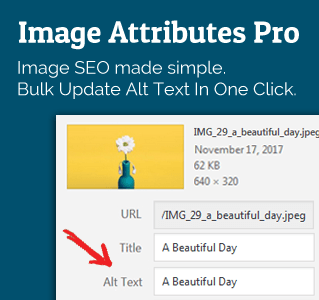WordPress is the most popular Content Management System (CMS) in the world, and most likely your website is running it. Since most of the websites are using it, it keeps evolving and getting better and better with every new iteration, bringing new features, speeding up, and making your life easier.

The best thing about WordPress is that it allows you to create and manage websites without prior knowledge of HTML.
Once you start your shiny new website, don’t expect WordPress to help you improve your Google search rankings. It’s a thing you need to do yourself.
On the other hand, WordPress will help you to implement SEO with ease, and improve your rankings, without much prior experience.
For starters, there are a couple of free plugins that can make the world of difference once you start using them: Yoast SEO, Smush, and W3 Total Cache.
Essential plugins
Yoast SEO will check the level of optimization of your content before publishing. It will let you see how your content will look in Google Search, and what you need to do to improve it. SEO and Readability analyses are there to help you improve the parts of your content that are not optimized.
Smush can help you optimize every image on your website, which will increase the speed and load times. There is also a Lazy load option that serves only images that are being viewed, and loads others when needed, further improving your website’s performance.
Legendary W3TC plugin caches website’s data in order to improve loading speed the next time a user opens up the same page, or even set of pages.
Pick the right (SEO) look
Once you start WordPress, you will be welcomed with the default theme, and you should forget about it, as fast as you can. With a large market for plug-ins and themes, WP offers an abundance of options, and you should take advantage of that, and pick a perfect theme for your website.
Search for a specific look and style and keep in mind that your theme should be optimized for search engines. That means, it should be lightweight and responsive, with mobile-friendly content.
Permalinks
A new website is an ideal canvas for SEO since you can start implementing things from the beginning, which is way easier than optimizing already existing websites.
In Settings of your WordPress, you can choose which type of permalinks you want to use. There are usually six options available, but the best one for SEO is Post name. It offers a page insight just by looking at it, and it allows you to use target keywords in the anchor text. This way you can increase your click-through rate in the SERP and boost your organic traffic.
So, pick a Post name permalink, and start thinking about your every post as an opportunity to improve your ranking and traffic.
Use internal linking
Besides permalinks, while adding your content, one of the things you should keep in mind is to enrich your content with internal linking.
We said “enrich” instead of “add”, because internal linking is more valued once they are placed smart and contextualized.
Google loves internal linking, and that’s a fact. With carefully placed internal linking, you can lead visitors to look for additional content on your website, especially the best one that you have.
One trick you can use is to add a sidebar widget with popular articles. This way you will improve their rankings and boost the number of visits to the articles you choose as popular.
Pick the right hosting
It might not look like a big deal but picking the right hosting plan for your website makes all the difference. Seek plans with fast servers, 24/7 support, WordPress acceleration, SSL integration, DNS management, and a lot of more specific features that your website needs like uptime guarantee, SSH access, automatic backups, and such.
We tried plans that Hostinger offers and found very interesting ones that are worth more than the money you are paying. There is one golden rule when it comes to hosting, and it says never to use free hosting, no matter how good the offer looks. Pick the provider that will give you what you need, for the money you are willing to pay, and enjoy doing the creative work on your site, instead of worrying about the server performance and uptime.
Never forget alt text for images
With more than 2.2 billion people in the world that have a visual impairment, your website has a big audience that uses screen readers. This is why search engines like alt tags for images, and exactly why you should too.
Don’t forget that today Google search engine result pages deliver nearly the same amount of image search results and text-based results. That alone should be enough to grasp the importance of alt text for images.
The description of the image should be simple and accurate, and you shouldn’t try to use your keywords here. Tags will provide search engines with greater context for the images on pages, further improving your rankings in Google Images, and search result pages.
Spend some time on titles and meta tags
The meta title is the title you see as a blue text title in the search results, and meta description is the text below the URL. Can you g
uess the importance of meta titles and descriptions? Instead of using generic text, you should spend some time and create a good title and description.
With limited space for meta text, try and keep it short and simple. You have between 50 and 60 characters for meta title, and around 155 for the description and the above mentioned Yoast plugin will help you with this, by telling you how much space you have left and letting you preview how your page looks in SERP.
Attractive titles can bring more visitors to your website directly from search engine result pages, so you should try to customize every post.
Use your essential plugins
Yoast is very helpful with content creation, but you should use all of your plugins once your website is up and running. With W3 Total Cache, the speed of your webpage will improve, along with loading times. And since page speed is one of the ranking factors, you do the math.
Since everyone likes media-rich pages, it is very easy for things to get out of control, with your page sizes hitting the roof. Smush plugin will help you keep the image size down to a minimum, without affecting the quality, which is the most important part. Also, by dynamically loading the parts of the website that the user sees, you are additionally improving the speed of your website.
The best thing is that these plugins are made to be beginner-friendly, and their usage is as simple as it gets.
Check your page performance
Once you are done making all these changes make sure to check the page performance with Google PageSpeed Insights which is a great tool to measure your web page’s optimization both on mobile and desktop. With helpful information, you can see the things you did well, and the ones that need improvement, so you’ll know where to point your crosshair next time.
WordPress can be a little scary in the beginning, but there is a reason why more than 37,6% of all the websites in the world use this CMS, and why it still has a steady increase every year (2% from 2019 and 4% from 2018).
Being easy-to-use helps users with little and no experience to use it every day. With a little help from plugins, and a couple of tricks, everyone can improve SEO and boost rankings in no time, so what are you waiting for? Check your competitors and start working your way to beat them in their own game.
Author Bio: Chris Kaplan. Innovative thinker, passionate about digital marketing, new technologies, and strategic marketing.






Leave a Reply